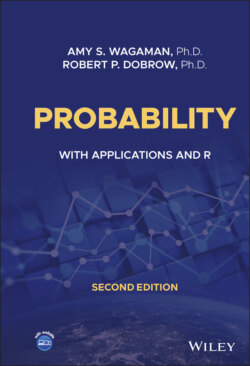Читать книгу Probability - Robert P. Dobrow - Страница 34
Binomial Theorem
ОглавлениеFor nonnegative integer n, and real numbers x and y,
Proof: It will help the reader in following the proof to choose a small , say , and expand by hand.
Observe that all the terms of the expansion have the form , for . Fix and consider the coefficient of in the expansion. The product consists of factors. There are of these factors to choose an from, and the remaining factors to choose a from. There are ways to do this. Thus, the coefficient of is , which gives the result.
Let in the binomial theorem. This gives
FIGURE 1.3: Pascal's triangle.
There is a combinatorial interpretation of this identity. The left-hand side counts the number of sets of size . The right-hand side counts the number of such sets by summing the number of subsets of size 0, size , and size .
Binomial coefficients appear in the famous Pascal's triangle, shown in Figure 1.3. Each entry of the triangle is the sum of the two numbers above it. The entries are all binomial coefficients. Enumerate the rows starting at at the top. The entries of each row are numbered from the left starting at . The th number on the th row is . The fact that each entry is the sum of the two entries above it gives the identity
(1.5)
The algebraic proof of this identity is an exercise in working with factorials.
Here is a combinatorial proof:
Question: There are students in the room, including Addison. How many ways are there to pick a group of students?
Answer #1: Choose students from the set of students in ways.
Answer #2: Pick students that include Addison. Then pick students that do not include Addison. If Addison is included, there are ways to pick the remaining students in the group. If Addison is not included, there are ways to pick the group (choosing from everyone except Addison). Thus, there are ways to pick a group of students.
The two solutions answer the same question, proving the desired identity.
Example 1.28 Ballot problem. This classic problem introduced by Joseph Louis François Bertrand in 1887 asks, “In an election where candidate A receives votes and candidate B receives votes with , what is the probability that A will be strictly ahead of B throughout the count?” The problem assumes that votes for A and B are equally likely.For instance, if A receives votes and B receives votes, the possible vote counts are given in Table 1.5. Of the 10 possible voting outcomes, only the first two show A always ahead throughout the count. The desired probability is We show that the solution to the ballot problem is A voting outcome can be thought of as a list of length with As and Bs. Thus, there are possible voting outcomes.TABLE 1.5. Voting outcomes for the ballot problem.Net votes for AVoting patternduring the countAAABB1,2,3,2,1AABAB1,2,1,2,1AABBA1,2,1,0,1ABABA1,0,1,0,1ABAAB1,0,1,2,1ABBAA1,0,1,0,1BAAAB1,0,1,2,1BAABA1,0,1,0,1BABAA1,0,1,0,1BBAAA1,2,0,1,2A receives three votes and B receives two votes.FIGURE 1.4: Illustrating the correspondence between “bad” lists that start with A and lists that start with B.Consider the number of outcomes in which A is always ahead. Clearly, such an outcome must begin with a vote for A. The number of outcomes that begin with A is , because the first element of the list is fixed and there are positions to fill with A's. Some of these outcomes are “good” (A stays ahead throughout) and some are “bad”. We need to subtract off the number of “bad” lists.To count such lists, we give a one-to-one correspondence between “bad” lists that start with A and general lists that start with B. To do so, we represent a voting outcome by a path where the vertical axis represents the number of votes for A. Thus, when a path crosses the horizontal axis, it represents a tie.See the example in Figure 1.4. The left diagram corresponds to the voting outcome AABABBBAAA. The outcome is “bad” in that there is eventually a tie and the path crosses the horizontal axis. For such a path, “reflect” the portion of the path up until the tie across the axis, giving the outcome in the right diagram. The reflection results in a path that starts with B.Conversely, consider a path that starts with B. As there are more As than Bs, at some point in the count, there must be a tie and the path crosses the -axis. Reflecting the portion of the path up until the tie across the -axis gives a “bad” path that starts with A.Having established a one-to-one correspondence we see that the number of “bad” lists that start with A is equal to the number of lists that start with B. There are lists that start with B. This gives the desired probabilityWe leave it to the reader to check that this last expression simplifies to
To round out this chapter, in the next sections, we examine some problem-solving strategies and take a first look at simulation as tools to help in your study of probability.
